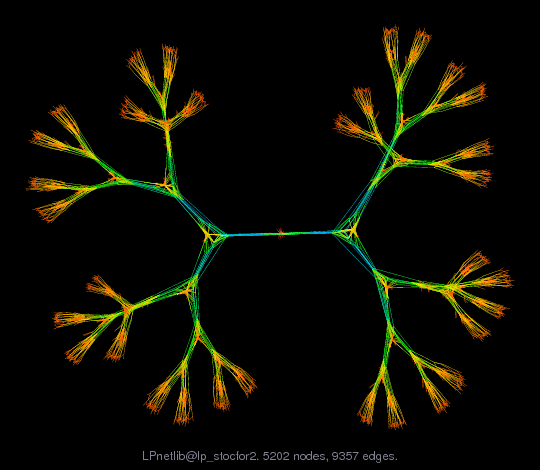
Matrix: LPnetlib/lp_stocfor2
Description: Netlib LP problem stocfor2: minimize c'*x, where Ax=b, lo<=x<=hi
 |
| (bipartite graph drawing) |
 |
 |
| Matrix properties | |
| number of rows | 2,157 |
| number of columns | 3,045 |
| nonzeros | 9,357 |
| structural full rank? | yes |
| structural rank | 2,157 |
| # of blocks from dmperm | 17 |
| # strongly connected comp. | 1 |
| explicit zero entries | 0 |
| nonzero pattern symmetry | 0% |
| numeric value symmetry | 0% |
| type | real |
| structure | rectangular |
| Cholesky candidate? | no |
| positive definite? | no |
| author | G. Gassmann |
| editor | D. Gay |
| date | 1988 |
| kind | linear programming problem |
| 2D/3D problem? | no |
| Additional fields | size and type |
| b | full 2157-by-1 |
| c | full 3045-by-1 |
| lo | full 3045-by-1 |
| hi | full 3045-by-1 |
| z0 | full 1-by-1 |
Notes:
A Netlib LP problem, in lp/data. For more information
send email to netlib@ornl.gov with the message:
send index from lp
send readme from lp/data
The following are relevant excerpts from lp/data/readme (by David M. Gay):
The column and nonzero counts in the PROBLEM SUMMARY TABLE below exclude
slack and surplus columns and the right-hand side vector, but include
the cost row. We have omitted other free rows and all but the first
right-hand side vector, as noted below. The byte count is for the
MPS compressed file; it includes a newline character at the end of each
line. These files start with a blank initial line intended to prevent
mail programs from discarding any of the data. The BR column indicates
whether a problem has bounds or ranges: B stands for "has bounds", R
for "has ranges".
The optimal value is from MINOS version 5.3 (of Sept. 1988)
running on a VAX with default options.
PROBLEM SUMMARY TABLE
Name Rows Cols Nonzeros Bytes BR Optimal Value
STOCFOR2 2158 2031 9492 79845 -3.9024408538E+04
STOCFOR1,2,3 are stochastic forestry problems from Gus Gassmann. To
quote Gus, "All of them are seven-period descriptions of a forestry
problem with a random occurrence of forest fires, and the size varies
according to the number of realizations you use in each period."
STOCFOR1 "is the deterministic version, STOCFOR2 has 2 realizations
each in periods 2 to 7, and the monster STOCFOR3 has 4,4,4,2,2, and 2
realizations, respectively." The compressed form of STOCFOR3 would be
652846 bytes long, so requesting STOCFOR3 will instead get you a bundle
of about 174 kilobytes that includes source for Gus's program, the
data files for generating STOCFOR3 and a summary of "A Standard
Input Format for Multistage Stochastic Linear Programs" by J.R. Birge,
M.A.H. Dempster, H.I. Gassmann, E.A. Gunn, A.J. King, and S.W. Wallace
[COAL Newsletter No. 17 (Dec. 1987), pp. 1-19]. Data files are also
included for generating versions of STOCFOR1,2 that have more decimal
places than the versions in lp/data.
Added to Netlib on 25 June 1988
| Ordering statistics: | result |
| nnz(V) for QR, upper bound nnz(L) for LU, with COLAMD | 105,467 |
| nnz(R) for QR, upper bound nnz(U) for LU, with COLAMD | 30,736 |
| SVD-based statistics: | |
| norm(A) | 1263.72 |
| min(svd(A)) | 0.0444897 |
| cond(A) | 28404.8 |
| rank(A) | 2,157 |
| sprank(A)-rank(A) | 0 |
| null space dimension | 0 |
| full numerical rank? | yes |
| singular values (MAT file): | click here |
| SVD method used: | s = svd (full (A)) ; |
| status: | ok |

For a description of the statistics displayed above, click here.
Maintained by Tim Davis, last updated 12-Mar-2014.
Matrix pictures by cspy, a MATLAB function in the CSparse package.
Matrix graphs by Yifan Hu, AT&T Labs Visualization Group.